Bronte is a relatively new flashlight manufacturer on the scene, based out of China. From some quick searching it looks like these are going to be in the "budget" price range. I'm sure many will have already formed an opinion about a Chinese company they haven't heard of before, but let's take a look and see how Bronte stacks up. I've been sent two lights from their "EDC" series and two from their "Outdoor" series for review, and the RA20 is from their Outdoor series.

Thanks to Bryan at Shiningbeam.com for supplying the RA20 for review.
I’ll be reviewing the RA20 in two sections: first, I’ll discuss the light objectively (the facts about the light itself), then I’ll discuss the light subjectively (my impressions about the light's performance when used for specific applications). This light could go as a long EDC or a general purpose outdoors light, so I'll be reviewing it as such. If you have any other specific applications you'd like the light tested for, let me know and I'll see what I can do.
Below is a video "quick review" you can watch in just a few minutes, if you're not up for reading the full review right now:
Objective
Spec-Check
In this section, you can see a quickly if I found the claims made about the light to be true. These specs are taken from the packaging of the light. As I test the light, when a spec is confirmed to be accurate (or close enough to be within the limits of experimental error), I will highlight it in green. If I find a spec to be inaccurate or misleading, I'll highlight it in red. Grey will mean that I can neither confirm nor deny it. Blue will be my comments added.
--------
from the packaging...
-Four output modes:
---Low: 20 LM, 75 H
---Mid: 110 LM, 3 H
---High: 220 LM, 1.2 H I measured a little under 220 lm, but it's within my error margin. The runtime regulated is well over 1.2 hours.
---Strobe: 220 LM
-Bulb: XP-G R5 LED
-Batteries: 2*AA Alkaline or NiMH
-Diameter: 23.5mm
-Length: 160mm
-Weight: 100g
-Waterproof to IPX-8 at 1.5m
-Impact Resistant at 1m
-Metal reflector with combination of throw and flood
-New switch with momentary on function
--------
Packaging


The packaging for the the Outdoor series lights I was provided has a bit more color to it than for the EDC series, and retains the cut-out viewing window for the light. Inside are the light,lanyard, two spare O-rings and a spare rubber switch boot in a plastic bag, and the manual/warranty card.

Construction Quality
The RA20 is powered by two AA sized batteries held end-to-end, so it's got a long and slim profile. The only protrusion from it's cylinder shape is the clip, which can be removed if you desire.

The RA20 has an overall good construction quality. There are a few things that could be done better, but this is a well made light.

This light is just slightly larger in diameter than a AA battery, and approximately the length of three.
Let's take a closer look, starting from the front...

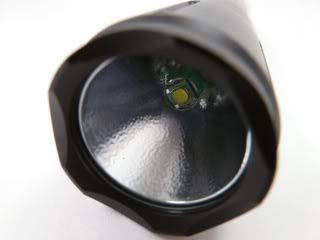
The RA20 features a Cree XP-G R5 emitter. The XP-G is currently the go-to choice for giving a light good throw from a small reflector. The R5 flux bin (brightness group) is the third brightest available for an XP-G, topped only by S2 and S3. This XP-G sits inside a reflector with MOP (mild orange peel) texture, which serves to smooth out any imperfections in the beam at the cost of a little throwing distance.
The emitter and reflector sit behind a small lens and O-ring, held against a solid head. The bezel of the R20 has smoothed crenelations that allow light to shine out when stood head-down, and give the light a rougher look.
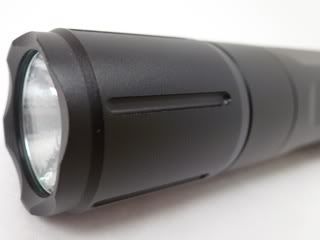
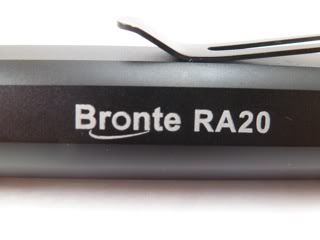

The head has several grooves cut in along the length, to give better grip and a little style. The body has the Bronte logo and the RA20 model number printed clearly on one of several flat sections, and this is the only writing on the light. The clip is connected between the body and the tail, and makes contact about halfway down the body. The clip feels sturdy enough, and springs back well from mild pressure.
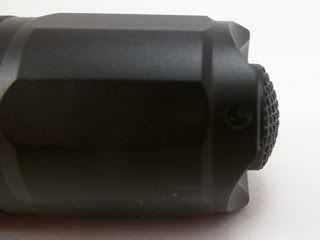
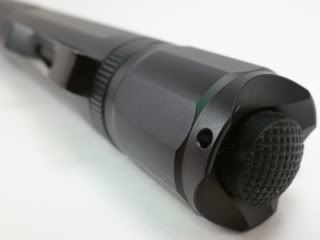
The tail has a ridged pattern to provide good grip, and the switch extends beyond the end of the crenelations on the tail. This means the light won't be able to do a tail stand, but it's very easy for your thumb to get to the switch when it needs to.
The clip is removable by hand, with no tools, if you so desire. This uses a great mechanism for making a secure but easily removable switch by attaching the switch below a screw-down locking ring between the body and tail.
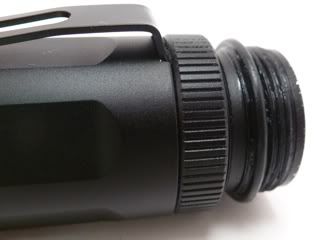

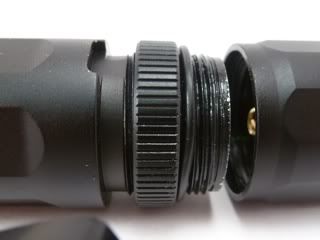
First, you unscrew the tail cap, and slide the O-ring down a bit. Then, unscrew the locking ring, revealing the clip. Pull the clip out, then re-tighten the locking ring and put the tail back on. Viola, no more clip. To put the clip back on, just reverse the process. In this way, the clip is very securely attached, but is easy to take on/off without the use of tools.
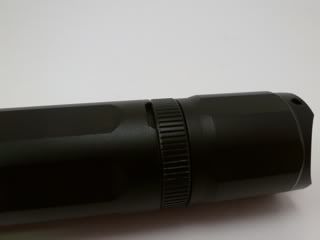

Removing the clip gives the RA20 a very sleek profile.
Now let's open it up!


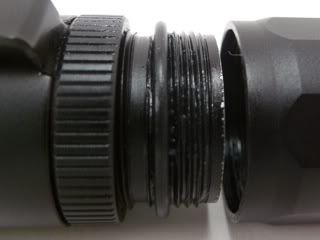
The head and tail come off from the body smoothly, to reveal triangle-cut threads. The threads to the head are un-anodized, providing the best possible electrical connection to the head, but giving them less protection from wear. The threads to the tail are anodized, so they will last longer, and the tail can be slightly loosened to "lock out" the light, keeping it from coming on during storage or long periods without use. Because only the rear threads are anodized, I'd suggest doing battery changes through the tail section to ensure maximum lifetime of your light.


On the left is the inside of the head, showing the positive battery contact. On the right is the inside of the tail, showing the spring that acts as the negative battery contact and keeps the battery firmly pressed against the head as well.
Accessories
The RA20 comes with a lanyard and holster.


The lanyard attaches to a small hole in the tail of the light. There is only a single hole, so you the lanyard has to pass around the outside of the tail section, but this doesn't really matter because the RA20 can't tail stand anyway (this lanyard hole design would normally prevent a stable tail stand when the lanyard is installed).


The light can easily fit in the holster either head up or head down, because of the slim profile.

The Bronte logo is imprinted on the top flap of the holster.
Dimensions
Length: 152.4mm
Outer Diameter: 22.8mm
Inner Diameter: 14.8mm
Clip Length: 41.6mm
Clip Width: 6.9mm
Clip Thickness: 0.6mm
User Interface
The RA20 has a straight-forward user interface that uses a switch in the tail and twists of the head.
There are four modes in sequence, Medium -> High -> Low -> Strobe. The switch in the tail is used only to turn the light on and off. It's a forward clicky switch, which means you can press it half-way for momentary on, or click it all the way into position for constant on. Another click will turn the light off. To advance to the next mode in the sequence, you loosen the head slightly (a little less than 1/8th of a turn) then tighten it again. This light does have mode memory, so whenever you turn the light on it will start in the mode you used last. The mode memory does persist through battery changes.
So, you have the option of setting it to your favorite mode and always using that one (you'll never see the others if you don't turn the head), or you can easily cycle through to a different mode without having to turn the light on and off.
Action Shots
Light in Hand



White Wall (Low, Medium, High)
ISO 100, f/3.3, 1/10"

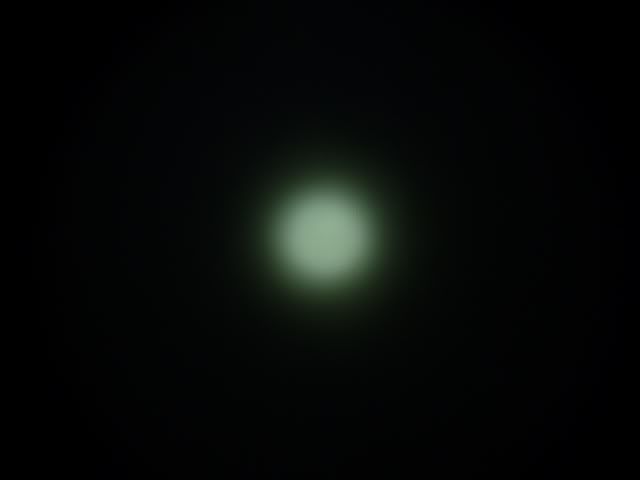

BeamSlice

Indoor Shots (Control, Low, Medium, High)
ISO 100, f/3.3, 1"

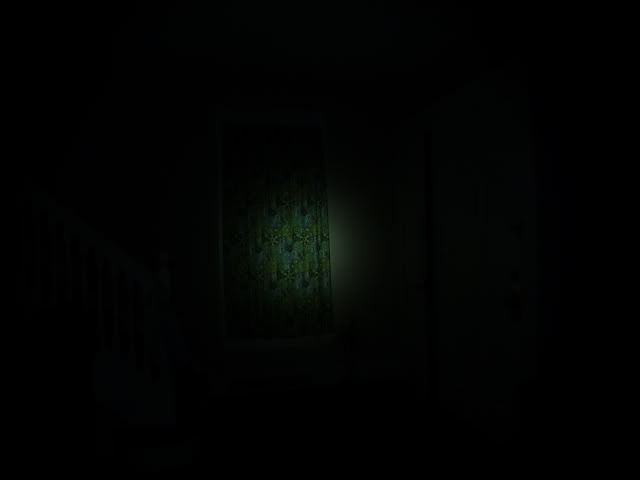

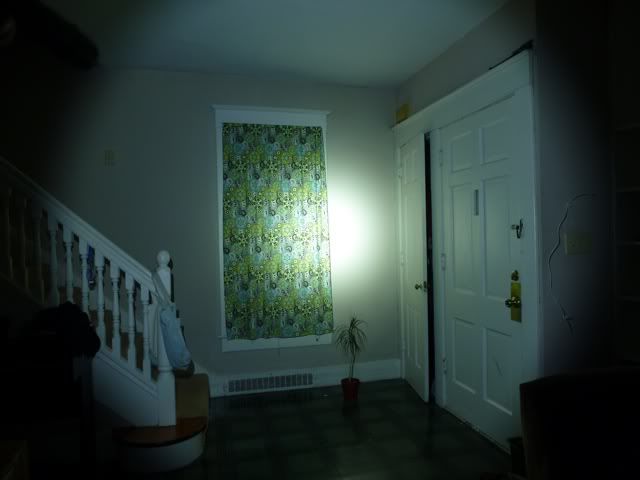
Outdoor Shots (Control, Low, Medium, High)
ISO 100, f/3.3, 2.5"
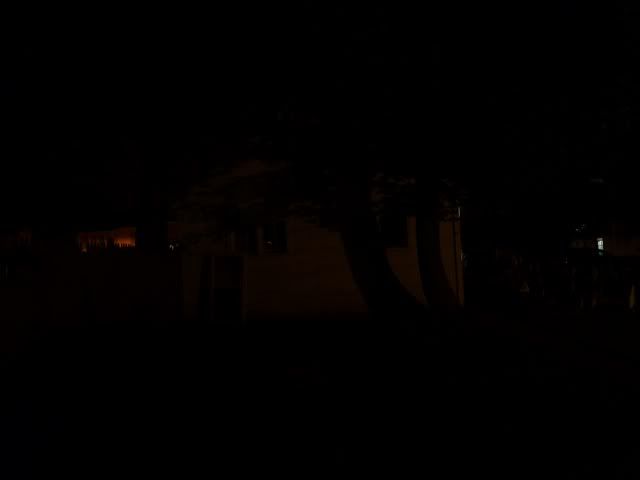
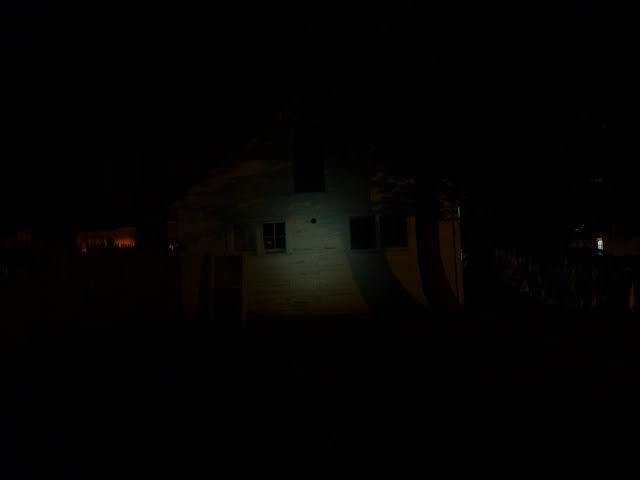

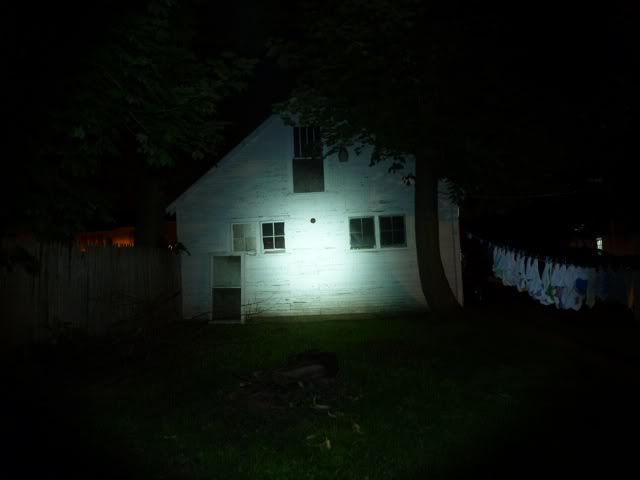
Performance
PWM: Pulse width modulation is used to make an LED appear dimmer by flashing it very quickly (thousands of times per second). I found that the RA20 uses pulse width modulation on the medium and low modes, but I could not detect any on high mode. There is no audible whine from the PWM.
Drop: I dropped the RA20 from a distance of about 2 meters onto several surfaces, including carpet, grass, packed dirt, and wood, and I can find no affect on the operation or performance of the light.
Reverse Polarity Protection: I can find no claims of reverse polarity protection by Bronte, so I have not tested this. However, the positive terminal of the RA20 on the circuit board in the head is not raised in any way, so it would be difficult (but not impossible) for the negative terminal of a battery to make a solid connection if the battery is inserted backwards.
Over-discharge Protection: The RA20 is not cleared for use with lithium ion batteries, so there should be no need for over-discharge protection.
Submersion: I submerged the RA20 under about a foot of water for about an hour. During that time I clicked the light on and off repeatedly, and changed the mode several times by slightly twisting the head. Afterwards, the light had no change in operation or performance and I could not find any evidence of water having entered the insides of the light.
Heat: I have not found the RA20 to build up any substantial heat, even while running on high for a long period of time.
Spectral Analysis
All light that we see as white is actually made up of several different colors put together. The relative intensities of the different colors in the mix are what determine the tint of the white we see. For example, cool white LED's have a lot of blue, and warm white LED's have more red or yellow. This measurement was done on a home made spectrometer. Note: the peak in the 900nm region doesn't really exist, it's a piece of the second-order spectrum that's showing up here because of the high intensity of the light source.
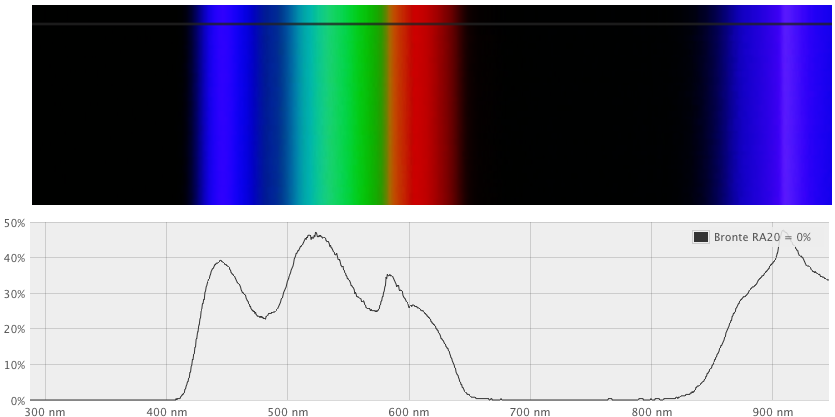
Runtime
Note: The vertical axis of this chart represents a relative brightness measurement using a home made light box. The horizontal axis is time in hours:minutes:seconds. Runtimes are stated in hours:minutes:seconds.
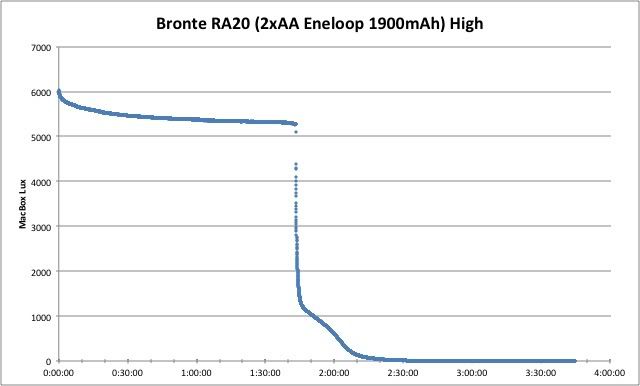
High
Time Regulated: 1:42:59
Time to 50%: 1:43:27
Full Runtime: 3:44:56
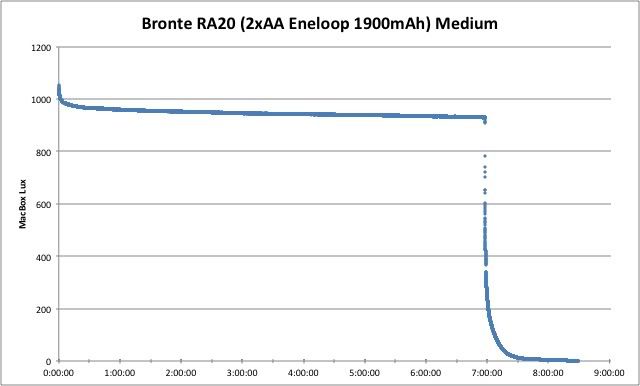
Medium
Time Regulated: 6:56:40
Time to 50%: 6:57:57
Full Runtime: 8:28:48
Coming soon...
Low
Time Regulated:
Time to 50%:
Full Runtime:
Subjective Review
General
Quick break down:
+Great regulation
+Common batteries
+Solid, easily removable clip
+Well spaced modes
+Acceptable build quality
+Simple UI (not click-through-modes)
+Good throw maintaining soft beam
-Visible PWM
-Strobe mode
This is another solid offering from Bronte, a basic 2xAA. While this seems well put-together and most things are done right (except the PWM and the strobe mode), nothing is really spectacular about the RA20. If you're looking for a basic 2xAA budget offering, this could be a good option.
I really like the design of the clip here, I've only seen it on a few other lights. The clip held down by the ring is easy to remove without tools, but is held on very solidly when you use it.
I also like the UI of the RA20. While it's not optimum, it's much better than the standard budget light where you need to turn the light off and on by the tail cap repeatedly. By using head twists to change modes, I can turn the light on and off at the tail cap and maintain the same output. I don't like the strobe mode. I'm not sure when so many manufacturers feel the need to include it as part of a regular UI, as so few people use it or want it. If it's hidden in such a way that it won't come up in normal use, that's fine, but I don't like how the strobe mode here is part of it's regular lineup.
The PWM here isn't too distracting for me, but I can tell it's at a lower frequency than most, so it might bother some people who are sensitive to it.
Overall, I'll wait to see the price to say for sure, but this looks like a respectable offering in the budget category that you'll be able to rely on more than the average whateverfire.
Note: If you're looking for a similar light that's a bit brighter, check out the Bronte RC20. It's the same light, but runs off of 2xCR123. I've even found the heads to be interchangeable. Same diameter, and a little shorter.
General Purpose Outdoors
As part of Bronte's "outdoor" series, the RA20 seems to fit the bill pretty well. It's got good enough grip and size that I'm not worried about dropping it, and it can handle the drops if I do. I like the XP-G/smooth reflector combo, it throws better than an XM-L in the same package and looks good doing it (no rings or artifacts). For an outdoor light, I'd prefer this XP-G over an XM-L light because of the added throw. I'd say the RA20 will work just fine as an outdoor light, and as a budget light, I'm not worried about throwing it in a pack and letting it get roughed up a bit.
Long Term Impressions
I'll fill this part in after carrying the light for a while. If nothing get's added here, either I find nothing else worth noting about the light, or I end up not using it often.